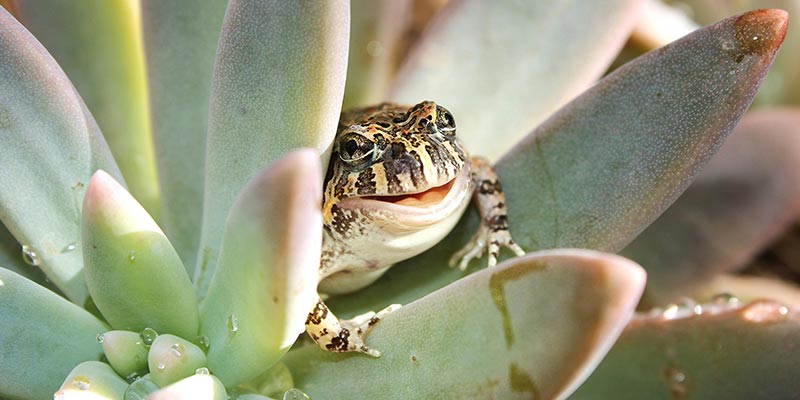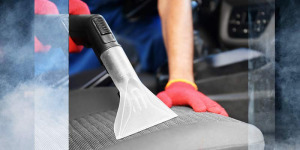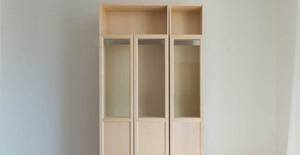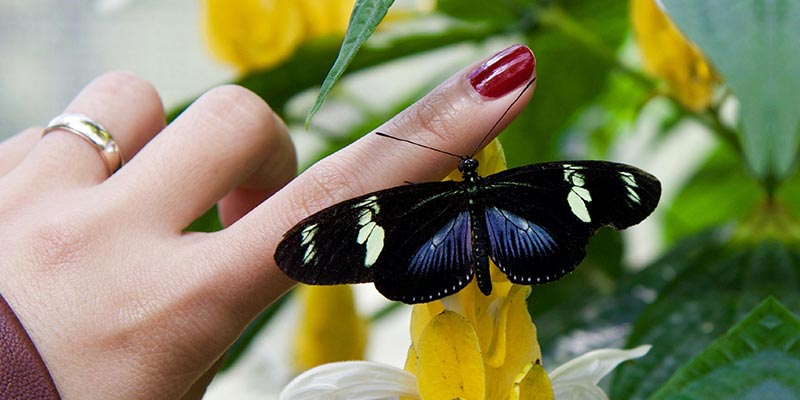Create a mini nature sanctuary around your tiny home, by attracting wildlife to your space. Discover how to invite wildlife in with these easy, natural methods.
Gardens are great places to unwind and enjoy the beauty of nature, no matter how small or large. Whether you enjoy getting your hands dirty or just taking in the loveliness, your garden is a place where you love to spend your time and get a breath of fresh air.
While some animals like rats are unwelcome pests in your tiny home sanctuary, others are welcome guests. Birds, amphibians, and butterflies living in and around your garden or balcony space provide a spectacular piece of nature, right next to your front door or window. It is therefore important to make your tiny home garden welcoming for wildlife. To attract these animals and beneficial insects, you need to offer shelter and ways of feeding them.
In this guide we will go over some of the most common and beneficial wildlife that you should welcome to your tiny garden spaces and how to attract them, whether you have a proper landscaped garden, vertical garden along a side wall, or a compact balcony.

How to Attract Wildlife to Your Tiny Home
#1 Plant a variety of trees, shrubs and flowers
A diverse range of plants is essential for attracting and making a home for all forms of wildlife.
#2 Provide a water feature
Like people, wildlife be it animal or insect, need to drink. Some rely on water to live (frogs) or to bather (birds). A water feature suitable for a tiny home could include a small pond, or perhaps even a re-purposed wine barrel!
#3 Keep out predators
These could include neighborhood cats, dogs or foxes if they are a threat to the wildlife in your garden.
#4 Avoid chemicals
There is really no need for chemicals in a garden. Chemicals such as pesticide sprays can unintentionally harm garden wildlife that you didn’t intend to, such as bees and frogs. Besides, you can avoid using harsh chemicals by knowing which garden wildlife and beneficial insects will help a garden flourish. Many of them are naturally in a garden and just need a little support to stay around. Others can be purchased or transplanted, and encouraged to stay by making your tiny house garden their new home by following the tips above.
Wildlife Species for Your Tiny Home Garden
Butterflies
Butterflies are a beautiful addition to any backyard. As a bonus, they will pollinate the flowers in your garden. The only problem with butterflies is they will lay their eggs on plants, and their larvae (caterpillars) will eat the plants. To prevent this, merely inspect plants often and remove any eggs.
Butterflies are another great animal to have nestling in your garden, as they are not only beautiful insects, but also won’t damage your plants in the process. To get butterflies to come to your garden, you should grow plants that will attract them. Butterflies love a whole slew of flowering plants. However, their favorite is the buddleia, which is even commonly referred to as the butterfly bush.
Brightly colored flowers such as the calla lily, lavender, crocosmias, and butterfly bushes attract butterflies to your garden. Most butterflies only lay their eggs on a specific type of plant. For example, monarch butterflies only lay their eggs on milkweed plants. Planting the plants that butterflies use to lay their eggs will keep them in your garden. Having plants that are tasty to caterpillars will allow you to watch their growth from eggs to larvae to butterflies. Butterflies feed on the nectar of flowers. They can also feed on tree sap, rotting fruit, and pollen. They get their water from mud or wet gravel.
Attract butterflies to your garden by providing:
- Bright flowers for butterflies to feed on
- Plants for butterflies to lay eggs in and caterpillars (larvae) to feed on
- The right type of plants – some butterflies have very specific needs (eg Monarch butterflies require Milkweed)
RELATED ARTICLE: How to Create a Butterfly Garden for Your Tiny Home

Bees
Okay, we may not all like bees because they can sting us, but they do work to actively improve your garden. Thanks to this, it’s helpful to have them around.
They are the ultimate pollinators, which means they will keep your garden, vegetables and fruits growing strong over time. Due to this, you’re going to want to have as many bees as possible flying through your garden.
Flowering plants like lavender have been known to attract bees to gardens. Bees are not destructive and they don’t lay eggs on plants like butterflies. Honeybees are easy to keep and are not as threatening as some people believe.
Attract bees to your garden by providing:
- Water feature, with ‘landing pads’ for bees
- Flowers, such as lavender
- Bee house
RELATED ARTICLE: How to Attract Bees to Your Tiny House Garden
Birds
Even though birds may poop on your outdoor furniture, birds are one of the best animals to have flying around your garden. That’s because birds eat those pest insects, which are known for completely destroying the vegetables, fruits and flowers you worked so hard on harvesting.
To attract birds to your garden, your greatest bet is growing plants that will bring them in. It’s important to note, though, that each bird has their own individual preference, so you will have to do your research first. For instance, humming birds love red flowers. You can also purchase bird feeders by your garden, to draw in more birds too. Remember, the more birds by your garden, the better.
Attracting birds is quite easy. All you really need are trees, shrubs and water. Birds need shelter, which can be in the form of tall trees where they can build their nests or provide them with bird boxes where they can live. Have plants that provide food for the birds, such as berries. You can also supply them with bird food to supplement the natural sources. Birdbaths are an attractive addition to any garden.
Attract birds to your garden by providing:
- Water (eg bird bath)
- Trees and shrubs
Hummingbirds
Hummingbirds are beautiful creatures to observe. I have separated them into their own section here, as there are unique tricks to attracting these lovely birds to your yard, that differ from other birds. Hummingbirds are attracted to colorful flowers and bright colors. You can set up a hummingbird feeder to get their attention (filling with brightly colored red sugar water) and keep them in your tiny home garden with trees and shrubs like the crabapple, lilac, rosemary, elderberry, and bush honeysuckle. The hummingbirds will eat the nectar of the flowers and take any other nourishment they need from insects found in the garden. This will also attract other wildlife.
Attract hummingbirds to your garden by providing:
- Hummingbird feeder, with red-colored sugar water
- Trees and shrubs with bright-colored flowers (especially red)
RELATED ARTICLE: How to Create a Bird Sanctuary in Your Tiny Home Garden

Frogs
Frogs are excellent animals to have in your garden, because they have been proven to eat both insect larvae and the insects themselves. This in turn helps keep down the insect population. Besides this, frogs are also great indicators of the health of your garden. To attract them to your garden, make sure that you’re providing a suitable environment.
Building a tiny pond in your garden is essential, if you want to encourage amphibians such as frogs and toads to live in your garden. Almost any size pond can become home to frogs and toads. A half wine barrel with a few water lilies and other water plants, makes a gorgeous rustic and compact addition to any tiny home garden or patio space.
Make sure to keep your pond or local stream clean and fresh, with absolutely no debris or pollution. Sloped sides will make it easier for them to get in and out of the pond, as they don’t spend their entire life in water.
During the winter, amphibians live outside of the water, so it’s good to have places for them to hide. They like to be under logs, under stones, and in piles of dead leaves. In the spring, frogs and toads will spawn. There will be thousands of young in the spring, but most of them will not survive, especially if you have fish in the pond as well.
Attract frogs to your garden by providing:
- A water feature (eg small pond) – no fish, kept clean
- Branches, stones placed above water (on which frogs can jump and climb in/out)
Spiders
Spider webs can be troublesome around your windows and when working in a garden, and some types of spiders (eg black widow, red back, funnel web) are venomous to humans.
However, dangerous spiders make up only a small proportion of all spiders, and having spiders is a good thing because they will capture and eat many of the insects and bugs that can wreak havoc on plants in a garden. Catching spiders and releasing them in the garden area will encourage them to move in and help out.
Fireflies
Another great insect for the garden is the firefly. These beetles feed on other insects as adults, and snails and slugs while in the larvae stage. They are completely harmless to people and plants, and their flashing lights can make a garden at night look more beautiful.
You can find plenty of outlets that will ship you a few hundred fireflies for your backyard. They won’t all hang around after you release them. However, it’s really fun to release a few hundred fireflies, anyway.
Final Thoughts for Your Tiny Garden
When most people think of animals, the last thing they want is for these creatures to be hanging around their garden. However, there are times when animals are actually quite beneficial. In fact, certain animals can actually take care of some of your garden challenges for you.
There are many forms of garden wildlife that can help your plants thrive and turn your space outside your tiny home into a tiny nature sanctuary. By creating an environment that is homely to our wildlife friends, we not only benefit from their ability to rid our garden of pests, but we can also enjoy the lovely presence they add to our gardens.
Author

Hi, I’m Rach, the other half of NestKoo. I grew up on a sheep farm in Australia where I spent most weekends in the yard fixing or constructing something or other; essential DIY skills that I still use today at home or helping others.
View all posts










